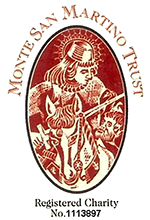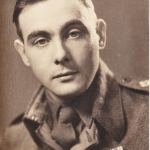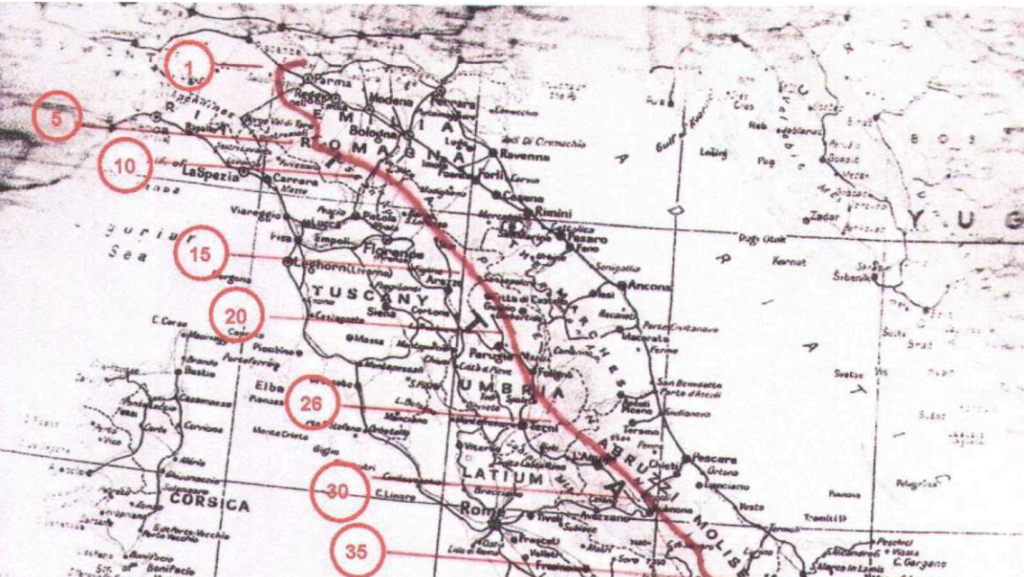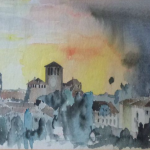Summary
Captain/Major Hawkins was captured by the Germans in Egypt after the fall of Mersa Matruh in 1942. He was imprisoned at Chieti where he planned to escape by digging a 180 feet long tunnel. Refused permission by senior officers to attempt escape during the Armistice, he was transferred to Sulmona. Here he hid above a hut ceiling with Lt. Tills and Sgt. A Sprout in spite of the Germans attempting to bomb them out. They escaped under the wire and walked back to the lines at Carunchio where he was admitted to hospital with stomach problems.
The full story follows, in two versions. The version in the first window below is the original scanned version of the story. In the second window below is the transcribed version in plain text.
[Digital page 1]
Major G.W.B. Hawkins K.O.R.s Captured 27/6/42 Chieti. Good on tunnelling. Armistice. O.C. of Camp allows no one to escape but those who had worked on tunnels to remain in them. Not enough room for G.H. so taken to Sulmona. Hid in roof of hut. Bomb thrown in but not much of roof fell in. Got through the wire. Pratola, Roccasasale. San Vettorino. Doonara, Pennapiedmonte. Torrecello. Montazzoli. Crossed Sangro. 6th November Osborne (see O’S account) and Sgt Spowert left for a walk and did not return (having passed some retreating Germans they continue through the lines. 9th Nov. with Lt. Tills made for Carunchio and got news of 350 (?) walking wounded Germans walking back. Contacted British Forces 10.30 hrs. Hawkins admitted to hospital with sinusitis and stomach disorders.
[Note in biro: At request of widow many donations sent to M.S.M.T. in his memory 2004.]
[Digital page 2]
[Handwritten notes at the head of the page]
G.W.B. Hawkins. In Chieti Tunnelled. Then Sulmona remained in roof in spite of bombs thrown in. Got out under wire. Died 2004. Many friends made contribution to M.S.M.
History of the 1st Battalion King’s Own Royal Regiment September 1939 to December 1943.
The personal account of his capture and escape by Major G.W.B. Hawkins MBE ERD.
55947 Captain George William Bowman Hawkins. The King’s Own Royal Regiment. POW in Italy after fall of Mersa Matruh 27 June 1942 until rejoining Allies 9 November 1943.
At Fuka on the night of 28/29 June 1942, I with my C.O. [Commanding Officer] Lt. Col. E.V. Everett was taken prisoner by the Germans, following the break-out from west of Matruh by 25 Indian Infantry Brigade of 10 Indian Division. We were handed over at Derna to the Italians who took us to Benghazi via Barche by road. We were then flown across the Mediterranean in a “Savoia” to Recce and taken by rail to P.G.75 at Bari from where we were transferred to Chieti on 5 August 1942.
This camp P.G.21, P.M. 3300, at Chieti appeared a very difficult camp to get out of, especially after several means of escape had been attempted and discovered by the Italians. It was therefore my plan to attempt what I considered to be a sound practical means of escape, namely to dig under the walls surrounding the camp.
The entrance to this tunnel was through a very small manhole over a rain water drain. When two opposite flags were broken off it was just possible to wriggle through. Earth from the tunnel was excavated (2) mainly by hand, although an iron bar about 1/2″ diameter and 18″ long proved an invaluable tool. By means of Red Cross cardboard food boxes the earth was transferred to the surface where at first it was dumped down a well in the courtyard, but later deposited around trees within the camp. Above ground careful watching had to be carried on to ensure the safe disposal of the earth, to keep under close observation Italian officers, sentries and carabinieri, and to watch for any sign indicating a Roll Call.
After some months of work the tunnel struck just below a sewer. This latter, which was of concrete, was broken open and the smaller members of the party working in shifts were able to crawl in and move left and right along this sewer. Henceforth most of the earth excavated was stacked in this sewer.
When it was calculated that the tunnel was beyond the double-apron fence on the far side of the wall, a vertical shaft was commenced. The estimations were at fault due to an unknown sudden rise in the ground on the outside of the walls. Thus instead of striking the surface at the estimated height above the tunnel of about (3) four feet, the surface could not be reached until after eleven feet! The tunnel needed very little work for completion just after the Armistice with Italy.
Briefly, the tunnel was about 180 feet in length. It had a large chamber at the entrance, a small one at the exit with one in the centre. Boxes of earth were transferred from the “face” to the chambers in small sledges drawn by plaited string. The air supply which was always a great difficulty towards the ends of shifts, came from bellows in the first chamber which puffed air to the
[Digital page 3]
face through Red Cross Meat Roll tins which were joined with sugar tins and buried in the side of the tunnel to form an air-pipe. As work progressed so the pump was moved to the second chamber where there was a small inlet from a rain water drain. Finally the pump was worked from the sewer, where there was also a supply of air, though not particularly fresh. Lamps were made from Marmite tins, with wicks from webbing equipment and oil from the cookhouse whenever it was available. Riveting was carried out where the (4) tunnel did not run beneath concrete. The wood for this was obtained mainly by members of the party breaking off boards from their own beds.
Carabinieri were often searching for tunnels. One tunnel was discovered in its very early stage & for the damage caused the Italians charged 5,000 lire or just under £70.
During working hours down the tunnel we wore long underpants and vests. These were essential to absorb perspiration when at the “face” and to keep warm when working in the rear. On several occasions the sewer overflowed after rain and the tunnel became impossible to work in. However parties would often descend soon after rain to bail out the water and dispose of the mud. Work was never comfortable. The size of the tunnel only just permitted working in the prone position and often the air was so bad that the lights would not burn. At one period day time work was restricted due to the activities of the Italians and night work was therefore commenced. This was never popular for after the maximum work had been done it meant sleeping in a confined space in very (5) damp clothes with numerous mosquitoes. Also, there was a serious risk of night Roll Calls or alternatively a bed check. To meet the latter possibility we always made up dummies in our beds when we were on night shift.
My plans of escape were never very concrete because events were moving so quickly that it was difficult to plan far ahead. Suffice it to note that a very rough plan Lieutenants Crocker, Bingham and Tills (R.H.A.)[Royal Horse Artillery] and I had in mind in the Spring of 1943 was to cross the Adriatic Sea to the Dalmatian Coast and eventually make our way to North Africa.
The conquest of North Africa, followed by the invasion of Sicily and later Italy caused many revisions of our plans.
The tunnel was planned to be ready for a break in the middle of September. The Armistice naturally slowed down work considerably. However, when it was doubted that we should be set free work was re-started. The Senior British Officer, Lt. Col. W.D. Marshall, later called a meeting for all officers and other ranks who had planned and worked for escape. At this meeting we were told that permission would only be given to a very small selected party to escape, as (6) orders had been received for the camp to “stay put” in the event of an Armistice. The S.B.O. added that we would escape “when the Germans fall us in to march us to the station”. We were given just over half an hour to decide whether we would like to apply to be included in this small selected party. I personally did not consider the escape of a small party from the camp would
[Digital page 4]
in itself hasten the arrival of the Germans and so prejudice the well-being (safety) of the officers and other ranks of the camp. Also, I had planned a much more hazardous method of escape than merely getting over the wall without the slightest interference from the Italians. My mind was set on escaping and in this opportunity I saw a good chance that would never be available again when the Germans had posted their armed sentries.
Lieutenants Bingham and Tills agreed to join me in asking for permission to “go over the wall”, but at 3pm permission was withheld from all and sundry and escape forbidden.
When the Germans did take over the camp the members working on all the various tunnels were told that they could go ahead with their plans.
The Germans took over P.G.21 on 21 September 1943 and at about 5pm on 23 September we were warned that a certain number of officers were being moved. This called for action on our part and, at a meeting of our Tunnel Party, which numbered 32, it was decided to use the Tunnel as a hiding place. The length of time we were to stay hidden was not definitely fixed but it was hoped that after the evacuation of the camp the German guard would be withdrawn and the Tunnel could then be used as it was originally intended. It was over this first point that there was a division. The whole party of 32 occupied the Tunnel for some 20 minutes at a time. After this many agreed that it would be impossible for 32 to stay down for any length of time and that it would be much the best if ten, or fifteen, names were drawn for. This would ensure that some, at least, would be successful, (8) whereas the whole 32 could not hope to be. 17 members were against such a number as 32 using the Tunnel but the remaining 15 were prepared to go down at all costs even if the whole 32 elected to go. It was only fair, therefore, that these 15 were left behind at Chieti when the Germans moved us to P.G.78 at Sulmona on the second and last day of their evacuation of Chieti Camp.
Immediately on arrival at Sulmona we thought in terms of hiding places. We were convinced that the Germans would move us North in spite of much optimistic talk to the contrary.
The bungalows at Sulmona unlike those at Chieti had lofts above their ceilings. We immediately cut a hole, about 3 ft square, in the plaster, passed up bed boards, water containers, etc. and covered the hole with a piece of 3 ply wood over which we had stretched a piece of old sheet. Camouflage was most difficult, the ceiling was old and materials were lacking. It seemed as if the whole Camp was making hide-outs of sorts. This was making it difficult, for it would mean a serious deficiency of personnel when the Camp was finally evacuated. Also, the Other Ranks, when moved the previous week, had been warned that if there were deficiencies in parade the roofs would be machine gunned. The roofs were known to be hiding places for one roof had collapsed during the bombing of Sulmona earlier on and had revealed the disposal of earth from one of the Camp’s Tunnels. The cover to the entrance to our attic was slightly improved by the substitution of
[Digital page 5]
drawing paper for the sheet. This paper was coloured with (10) “Marmite” to match the remainder of the ceiling. Nevertheless, the hole was so obvious that we decided to bluff the Germans. In this, they themselves helped. On Wednesday 30 September, all remaining British officers were moved by the Germans to Sulmona Railway Station. I remained behind with Lt. Tills and on Thursday morning hid for about 3 hours, underneath a bed during the German Roll Call and Search. The next day two Other Ranks went into hiding and we two officers took their places on Friday’s Roll Call. In the evening of the same day, the Germans in searching the Camp found our hole in the ceiling and they pulled away the 3 ply covering. Nevertheless at 7pm we went into this same roof where we were to remain for a week. We had increased our party to three with the addition of Sgt. A. Sprout, who in civilian life had been a miner and who had given us advice regarding the safety of our Tunnel at Chieti. The following morning we were informed that the remainder of the personnel in the Camp was being evacuated at once.
However, the Germans did not leave, in fact they began to convert the next-door bungalow into what we later discovered to be a workshop. We had to keep extremely quiet both day and night for we could always hear Germans nearby. At night we did two hours sentry duties in turn. On the fifth night we heard a commotion and guessed that someone had been discovered in the Camp. This was confirmed the next morning when a British Officer came round to each bungalow, under German escort and said ” We were discovered by the Germans last night after hiding in the Camp for five days. The German Commandant knows that there are still others hiding in the Camp and he gives them two hours in which to decide to come out of hiding. After that time he will have the Camp destroyed and people hiding will have to take the consequences.” This caused us some concern and we discussed how the Germans might destroy the Camp, Each experience sounded nearer than the preceding one, until we could hear the footsteps of the Germans with the explosives. We had argued that since we would hear no tiles or rafters flying through the air after the (12) explosions, the effect of the bombs was just local. We had a hair raising moment when we heard something metallic strike the floor of our bungalow. However, nothing happened until the German party arrived and placed a charge near the doorway just below us. We had piled our kit and were sitting on it, hoping it would contain the blast. The bomb exploded with an ear-splitting sound but only a small portion of the ceiling was blown through. This was only five feet from us, but sufficiently far away from the Germans to be unable to see us. We breathed a sigh of relief and the party below disappeared. The afternoon proved to be another nightmare for the Germans continued with their explosions. We thought nightfall would mean the end of their efforts, but next morning the explosions continued as before. Our water was now running low and since the nervous tension was proving a strain, we decided to make a break at 7pm that evening. We lowered ourselves down to the floor after having taken about 3 hours to move ourselves and our escape kit silently from one end of the bungalow to the hole in the centre. We reconnoitred one of the main gates but found it locked, so we decided to crawl through the barbed wire on the side farthest away from the “Commandos” Office. We managed to get through two wire fences without being seen. We had gathered from shots fired on previous
[Original page 5 is missing from the pdf and this transcript]
[Digital page 6]
some suspicion as we knew she had conversed and did converse with visiting Germans. We intended to rest one night more and proceed the next, but rain prevented us from moving. We were offered shelter in a barn for the night. This we accepted, but were rudely awakened the next morning and told to flee to the mountains as the Germans had arrived and were searching the village. The local Italians were petrified to have us near them and they indicated to us the mountains. We returned to our grotto just in time to see a German sentry scanning the countryside. Soon after this we heard Tommy Gun fire, but then we could hear Machine Guns and Mortars. The Germans were trying to clear the valley of prisoners and Italian workers, but by the end of the day they had caught no one.
Movement that night was impossible. The next evening the Italians tried their hardest to persuade us to stay. However, we heard the pm B.B.C. news on a radio hidden in the village and as we were disappointed over it we moved on to Deconoria. This journey took us across the extremely difficult “Dead Valley”. We took most of the night to get to the other side of this formidable obstacle. At dawn we arrived at the village to discover that two German soldiers had been enquiring about British prisoners only the previous evening. Thus, after a few hours rest we again moved on. We found a shepherd’s hut where we baked some potatoes but only stayed until 0100 hours. Travelling was now most difficult for the Nagilla we were now crossing was mainly trackless. However, the one and only track which we had to take for our direction led us straight through Pennapiedmonte. There was no alternative, so we passed through (17) the village at midnight. We lost our way right in the middle of this huge village perched on the mountain side, and had to wait until the moon rose to find our way.
The Italians were very scared of the Germans. Some told us that men in British uniforms had been shot by the Germans whilst some told us that prisoners in civilian clothing had been shot. However, we changed some of our Battle-Dress for very inferior Italian clothes. It was a poor bargain but we trusted we were acting wisely. We called at a house for food during the hours of darkness and discovered a most distressed Italian. His home had been knocked to the ground and his outhouses burned by the Germans because he had given food to American prisoners. All he had was three badly burned loaves from the destroyed bakehouse and a few grapes. We were hungry so were glad to get this food even though it was not in the least palatable. We crossed the River Avellino after passing San Martino where there were several German cars parked near a huge electrical plant. On the river bank we just avoided a German post. At dawn the next day we were hiding in most excellent cover. It afforded perfect protection as I discovered later that day when at dusk I (18) went out to contact some Italian children taking home cattle, only to discover a German sentry standing just about fifty yards away watching the Italians returning to the village after a day in hiding in the woods. On 22 October we reached Torrecello and met some very friendly Italians from whom we completed our civilian kit. We then made for Bonnenotte from where we were to cross what we had considered our biggest obstacle, the River Sangro. Near Bonnenotte we stayed in a straw shed belonging to a friendly Italian. The next day we had to hide as the Germans were carrying out another search for escaped
[Digital page 7]
prisoners, Italian workers and animals for food. At about 1800 hours on 25 October we crossed the Sangro without incident. We then walked for nearly ten hours before reaching the woods near Montazzoli.
The next day we set out for Torrebruno but very bad weather set in and we were held up. Rain came down very heavily which made the ground very, very muddy. Travelling at night, apart from this, was well-nigh impossible as there was no moon and dark clouds. We occupied a straw hut, which gave us a little shelter. We contacted a farm-house and were promised an evening meal at dusk each day. We were (19) beginning to feel quite ill now, for we had had violent stomach disorders. We could not discover what was the cause, the water, the over-ripe grapes, the unripe tomatoes or the weather. It was now very cold with snow appearing on the nearby Majella.
By now we could hear lively artillery duels and we realised with the machine-gunning that we were within easy reach of the Allies. We now intended to play for safety after getting so near. There we stayed much longer than we would normally have done. On 6 November Osborne and Spowert left for a walk but did not return at lunch time as intended. I have since discovered that on their stroll they saw German troops moving back and seeing an opportunity to pass through them they did so and reached the Allied Lines. On 9 November Lt. Tills and I took with us two Italians who wanted to join the Allied Forces and made our way to Carunchio. By waiting these extra days we were able to get news of a party of 350 German walking wounded which was making for Roccarpinalveti. With this party located we moved forward and at 1030 hours we contacted the British Forces. We then made for Furchi from where we made our way to Termoli, Foggia, Bari and finally Taranto where I was admitted to hospital suffering from chronic sinusitis and stomach disorders.



